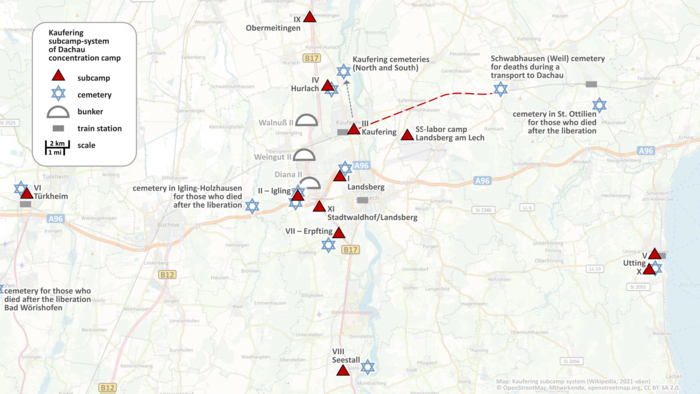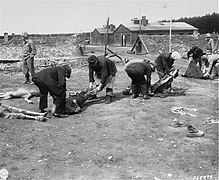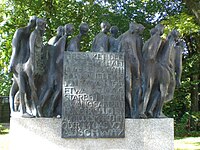Kaufering concentration camp complex
| Kaufering I–XI | |
|---|---|
Elkhanan Elkes | |
| Website | www |
Kaufering was a system of eleven
Previously, Nazi Germany had deported all Jews from the Reich, but having exhausted other sources of labor, Jews were deported to Kaufering to create three massive underground bunkers,
Kaufering was the largest of the Dachau subcamps and also the one with the worst conditions; about half of the 30,000 prisoners died from hunger, disease, executions, or during the
Establishment

In early 1944,
Previously, Nazi Germany had attempted to make the Reich
Forced labor
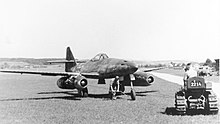
Unusually, the construction of the camps, as well as providing food and medical care, was the responsibility of the
Most prisoners were forced to work building railway embankments and hauling bags of cement for the bunker-building projects,[5] codenamed Weingut II, Diana II and Walnuss II.[8] Weingut II was 400 metres (1,300 ft) long and 28.4 metres (93 ft) high (more than five stories), with a concrete roof 3 metres (9.8 ft) thick. The roof had been planned to be 5 metres (16 ft) thick, but that was pared down due to lack of materials. The total floor area would be 95,000 square metres (1,020,000 sq ft); the Augsburg factory that it intended to replace had only 12,700 square metres (137,000 sq ft) of floor area in three dispersal locations. For protection from air raids, 40% of the bunker was underground and its roof was covered with dirt for camouflage. At least 10,000 Jewish prisoners worked on the bunker at some point.[9]

The bunkers were to be used for producing different components of the
The murderous conditions meant that most prisoners were incapacitated in a short time, and OT and construction workers brutally beat victims in order to extract labor. Most prisoners were forced to work building railway embankments and hauling bags of cement for the bunker-building projects.[5] OT workers complained that, due to severe vermin infestation, prisoners spent time attempting to rid themselves of fleas when they were supposed to be working.[6] In December 1944, an OT staff member observed that of 17,600 prisoners, only 8,319 were capable of work, including those only capable of light work. Because the companies that hired the workers complained that they had to pay for the labor of prisoners unable to work, transports totaling 1,322[5] or 1,451 people were dispatched to Auschwitz in September and October 1944, where the victims were gassed.[12]
Command and organization
The SS hierarchy at Kaufering had mostly served at eastern death camps, such as
Consisting of eleven subcamps, Kaufering was the largest of the Dachau subcamp systems,[1] and probably the largest Jewish subcamp system in the Reich.[13]
List of Kaufering subcamps


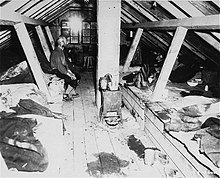
| Overview – Kaufering concentration camp complex[14] | ||
|---|---|---|
| Eleven subcamps |
Period, scope, use, conditions, specials | Place address |
| Kaufering I – Landsberg
|
(before late September, designated Kaufering III) was opened on 22 June 1944 and served as the headquarters of the Kaufering command from September. Located near Landsberg am Lech, the main purpose of this camp was the construction of bunker Weingut II. Between 2000 and 5000 men lived there; in February 1945, 200 women also arrived there. Because of overcrowding, Kaufering XI was established and some prisoners moved.[15] A group of seven Hungarian Jewish women, known as the "Schwangerenkommando" (pregnancy unit), who had conceived before their deportation to Auschwitz, was allowed to remain alive and bear their children.[5][16] | Landsberg am Lech nahe Iglinger Straße |
| Kaufering II – Igling | Established on 24 August. Its prisoners, about 1200 men and women, mostly worked at the "Diana II" construction site. The camp existed at two locations, a summer camp built with plywood and a later camp, occupied during the winter months, which offered slightly better protection against the winter weather.[17] | Igling 48°03′00″N 10°49′23″E / 48.0499468°N 10.8229218°E |
| Kaufering III – Kaufering (first "I", later "III")[18] |
(designated Kaufering I until September) was the original Kaufering camp, located near Kaufering and established by 1000 Hungarian Jewish men from Auschwitz on 18 June. These prisoners were forced to build their own accommodation. Later, prisoners were forced to work on the Weingut II bunker as well as the construction of Kaufering I and II. It served as the SS headquarters of the Kaufering complex until this was moved to Kaufering I in September 1944. The average population was 2000 men and 339 women. The senior prisoner was Victor Nečas, an Austrian political prisoner who communicated with the prisoners mostly in Hungarian.[19] |
|
| Kaufering IV – Hurlach | [de, he, pl], located between Kaufering and Hurlach, was established in September 1944 for 500 prisoners; the population later grew to 3000. Prisoners were forced to work at the Lagerlechfeld airfield, in road construction, and on the bunker Walnuss II until Kaufering IV was converted into a "sick camp", where prisoners were sent to die after they could no longer work.[20] A typhus epidemic broke out, and Dr. Blancke and the SS guards would not enter the barracks to avoid infection. Prisoner doctors could do little, as they had no medicine or equipment.[21] The Kaufering IV camp was liberated by the American Army in April 1945, when the SS began to prepare the surviving prisoners for the death march towards KL Dachau. A few days before the liberation, the SS crew killed hundreds of sick, wounded and incapacitated prisoners, which brought the number of soldiers who survived the camp to several hundred. It is estimated that there were 3,000 prisoners in the camp.[22] | Kolonie Hurlach |
| Kaufering V – Utting | Near Utting, has an unclear history due to inconsistent testimony from survivors. It is possible that it was only a subarea of Kaufering X, such as the kitchen, rather than a separate subcamp. [23]
|
Utting am Ammersee |
| Kaufering VI – Türkheim | [de] Was established in October 1944 at Türkheim, and housed between 1000 and 2500 prisoners, who were forced to work clearing nearby forests, in agriculture, and in construction. Many of the prisoners were later transported to other Kaufering subcamps to work on the bunkers.[23] | Türkheim |
| Kaufering VII – Erpfting | Was established on 11 November 1944 near the offices of Held & Francke. Between 2000 and 3000 men and 118 to 272 women were forced to live in huts and clay bunkers and work on prefabricated parts for "Diana II". After a typhus epidemic, sick prisoners were taken to Kaufering IV.[24] | Erpfting |
| Kaufering VIII – Seestall | At Seestall, was likely established as a mistake on the Germans' part, because the local soil was not suitable for the construction of bunkers. It was smaller than the other camps, and prisoners were forced to work on agriculture and gravel extraction.[25] | Fuchstal/Seestall |
| Kaufering IX – Obermeitingen | Was a men's camp that existed from 14 October 1944 in Obermeitingen. Its prisoners were forced to work on Walnuss II.[25] | Obermeitingen |
| Kaufering X – Utting | Established on Holzhauser Street in Utting on 26 September, housed 200 to 400 men forced to produce prefabricated components for the Dyckerhoff & Widmann firm. Because the prisoners worked indoors, their chances of survival were higher than at other subcamps.[25] | Utting am Ammersee |
| Kaufering XI – Stadtwaldhof/Landsberg | From late October, was established on Mühlweg Street in Landsberg to house surplus prisoners from Kaufering I. It consisted of barracks, clay bunkers, earthen huts, and a delousing center.[25] | Landsberg am Lech |
Prisoners

About 30,000 prisoners passed through the Kaufering camps,
Some of the food allotted to prisoners was diverted by SS guards, further reducing the nutrient intake of prisoners. Those who were sick, with diseases such as typhus, spotted fever, and tuberculosis that were widespread in the camp, were fed even less,
And – the attrition was very very high. And – but there the bodies weren't burned. They were taken to a site in mass graves, huge mass graves. I don't think they have ever been found. I wouldn't be able to find outside Kaufering. And huge mass graves. It's not very far from the Landberg prison [...] And – it was so bad – that – we had a lot of suicides there. People were going into the electric wires. And I remember, that's the only time I ever saw cannibalism. There was so little food in '45 there out – in January, February, in March...
— William J. Lowenberg, Interview, January 28th, 1993[35] (see video below)
A commission established after the war estimated that 14,500 Kaufering prisoners had died. German historian Edith Raim wrote that about half of the 30,000 prisoners died before liberation. The main causes of death were hunger, disease, execution, deportation to Auschwitz, and the death marches.[33][36] According to American historian Daniel Blatman, about 4,300 of those victims died at Kaufering itself; additional victims were sent to Dachau after becoming unable to work, or were killed during the death marches.[37]
Death marches

As Allied troops approached, rumors circulated among the prisoners that the Germans were going to massacre them before liberation. In mid-April, SS general Ernst Kaltenbrunner relayed orders from Adolf Hitler for the Luftwaffe to bomb Dachau, Landsberg, and Mühldorf, which all had high Jewish populations. The Gauleiter of Munich, Paul Giesler, ordered Bertus Gerdes, administrator of Upper Bavaria, to prepare plans for the extermination of the surviving prisoners. Gerdes prevaricated, citing the lack of airplane fuel and ammunition as well as poor weather. In response, Kaltenbrunner ordered that the Kaufering prisoners be taken to Dachau main camp, where they were to be poisoned. Gerdes ordered a local doctor to prepare poison, but this plan could not be implemented either. The third plan was to take the prisoners to Ötz Valley in the Alps, where they were to be murdered "in one way or another".[38]
According to German records, 10,114 prisoners, including 1,093 women, were at Kaufering camps during the last week of April. Most of them were evacuated to Dachau or locations further south, either on foot or by train.
Hundreds of the evacuees from Kaufering arrived at Buchberg labor camp (south of Wolfratshausen) on 29 April. Otto Moll, a functionary of Kaufering, attempted to massacre these prisoners but was foiled by the camp commander. Instead Moll killed 120 or 150 Russian prisoners from Buchberg.[41] Many of those who left Kaufering were liberated at Dachau on 28 April, but others were forced to march southwards into Upper Bavaria and were not freed until May. Kaufering IV, where those incapable of walking were held, was set on fire on the orders of the SS doctor, Max Blancke.[33] Hundreds of sick and emaciated prisoners were trapped inside and killed. Shortly afterwards, Blancke committed suicide.[21]
- Kaufering after liberation
-
Charred corpses at Kaufering IV
-
German civilians forced to bury victims
-
Five of the seven "Schwangerenkommando" women, and their infants, after liberation
Liberation and aftermath
The subcamps of Kaufering were liberated between 24 and 27 April 1945 by the Seventh United States Army.[39]
The
Our first sight of the camp was appalling. Inside the enclosure we could see three rows of bodies, approximately 200, mostly nude. We entered the camp to look it over. The bodies were in all shapes and conditions. Some were half burned, others badly scorched. Their fists were clenched in the agonies of their death. Their eyes were bulging and dilated as though even in death they were seeing and enduring the horrors of their lives in prison. None were more than skin and bones. The camp had been partially destroyed by fire, these were the victims.[44]
Nine of the forty defendants of the
Commemoration

There are dozens of "
At the beginning of the 1980s, a private association called Landsberg im 20. Jahrhundert (Landsberg in the 20th Century) was formed to commemorate Kaufering. The site of Kaufering VII was purchased after a Jewish survivor donated the money on the condition that a memorial be erected, which has not been accomplished.[49] In 2014, the federal government gave 700,000 euros to the European Holocaust Memorial in Landsberg (Landsberg Holocaust Memorial Association) and the city of Landsberg donated land with architectural remains.[49] Restoration work was done between 2009 and 2016 on three intact and three ruined earthen huts and the housing of the SS guards, by the Europäische Holocaustgedenkstätte, winning the Bavarian Historic Conservation Prize in Gold.[50] The site is fenced off and not accessible to visitors, but there are informational and commemorative plaques nearby.[51] According to historian Edith Raim, the Landsberg im 20. Jahrhundert association and its director, Anton Posset, have refused access to the site to survivors and their families, the Israeli ambassador Shimon Stein, and inspectors of the Bavarian List of Monuments.[49]
Besides Kaufering VII, there are hardly any remnants of the Kaufering subcamps, whose locations were only definitively established due to Raim's work.[52] Most of the sites are now used for gardens, forests, agriculture, or housing. Landsberg am Lech has a prominent plaque in the center of town commemorating the German soldiers who died in both World Wars, but no memorial to the Holocaust victims.[47] There is a modest memorial at Kaufering III,[53] while a student project to establish an information board was not maintained and fell into disrepair.[54] Only grave markers remain at Kaufering II and VI.[51] A tennis court operates on the former site of Kaufering I,[34] while Kaufering VI has been built over and there is a McDonald's nearby.[47] Traces of the fire set by the SS at Kaufering IV were destroyed by gravel-mining in the 1980s;[55] a hunting tower resembling the guard towers at concentration camps was erected by a local resident, which one visitor found "rather disturbing".[47]
Only one of the bunkers built by slave laborers, Weingut II, survives. During the 1960s, it was repurposed for use by the Bundeswehr, as part of the Welfenkaserne facility,[52] and is still in use as a repair facility by the German Air Force, as of 2018[update].[47][56]
- Kaufering memorials
-
Memorial at the train station in Kaufering
-
Kaufering III memorials
-
Memorial at Landsberg am Lech mass grave
-
Entrance to the cemetery at Türkheim (Kaufering VI)
List of cemeteries of Kaufering subcamps
see German article with pictures
- Concentration camp cemetery for the Kaufering I – Landsberg remote camp (Landsberg industrial estate) 48°03′50″N 10°51′16″E / 48.063785°N 10.854417°E
- Concentration camp cemetery for the Kaufering II – Igling remote camp (near the Aussiedlerhof, built by the concentration camp command of Otto Moll, the gas chamber commander of Auschwitz) 48°03′04″N 10°49′17″E / 48.0510579°N 10.8214350°E
- Concentration camp cemetery for the Kaufering II – Igling and XI – Stadtwaldhof/Landsberg remote camps (Landsberg/Holzhausen intersection) 48°02′52″N 10°49′14″E / 48.047752°N 10.820472°E
- Concentration camp cemetery for the Kaufering III – Kaufering remote camp (barrage weir) 48°06′46″N 10°51′32″E / 48.112719°N 10.858956°E
- Concentration camp cemetery for the Kaufering IV – Hurlach external camp (barrage weir), for those who were found later 48°06′48″N 10°51′33″E / 48.113345°N 10.859092°E
- Kaufering IV – Hurlach Cemetery of the Holocaust, April 27, 1945, directly in the former concentration camp area, built by the American liberators 48°06′10″N 10°50′43″E / 48.1027219°N 10.8452623°E
- Concentration camp cemetery for those deceased after liberation in Holzhausen/Buchloe 48°02′43″N 10°47′11″E / 48.0451668°N 10.7864566°E
- Concentration camp cemetery for theKaufering VI – Türkheim remote camp in Türkheim-Bahnhof 48°03′13″N 10°36′46″E / 48.053637°N 10.6128850°E
- Concentration camp cemetery for the Kaufering VII – Erpfting remote camp (near the Maria oak chapel, at the junction Landsberg - Erpfting district) 48°01′35″N 10°50′40″E / 48.026261°N 10.844477°E
- Concentration camp cemetery for the Kaufering VIII – Seestall remote camp (at the barrage weir at Lech in Seestall) 47°57′48″N 10°52′45″E / 47.9633616°N 10.8791459°E
- Concentration camp cemetery for the Kaufering IX – Obermeitingen concentration camp remote camp – unknown.
- Concentration camp cemetery for the Kaufering V and X – Utting remote camp (on the connecting road from Utting to Holzhausen) 48°00′51″N 11°05′10″E / 48.01409°N 11.08612°E
- Concentration camp cemetery in Sankt Ottilien for survivors of the transport train to Dachau of 27 April 1945 next to the Christian cemetery of the monks of the monastery Sankt Ottilien 48°05′40″N 11°02′52″E / 48.0943491°N 11.0478698°E
- Three concentration camp memorial stones with Hebrew inscription indicate: "Dead Jewish victims of an air raid on the transport train with Jewish concentration camp prisoners of the Kaufering concentration camp command of 27 April 1945". 48°06′08″N 10°58′26″E / 48.102298°N 10.974019°E
In popular culture
The liberation of Kaufering IV was depicted in the second half
Austrian psychiatrist Viktor Frankl was deported from Theresienstadt to Kaufering via Auschwitz in October 1944; he spent five months in Kaufering III and was transferred to Kaufering VI in March 1945.[61][62] His 1946 memoir, Man's Search for Meaning, has sold more than ten million copies and been translated into 24 languages.[63] Large parts of the book are purportedly set in Auschwitz, where Frankl spent only three days, but actually depict his experience at Kaufering.[64] In the book, Frankl develops his theory of logotherapy and argues that prisoners who maintained a positive attitude were more likely to survive. His work has however not been positively received by Holocaust historians, who maintain that Frankl's theories do not explain why some prisoners survived and others did not.[65]
References
- Citations
- ^ a b c d e f Raim 2009, p. 488.
- ^ a b c d e f g "Kaufering". United States Holocaust Memorial Museum. Retrieved 9 January 2019.
- ^ Fenner 2012, p. 133.
- ^ Raim 2009, pp. 488–489.
- ^ a b c d e f g h i j k l m Raim 2009, p. 489.
- ^ a b Fenner 2012, p. 145.
- ^ Bazyler & Tuerkheimer 2015, p. 83.
- ^ a b c d e Uziel 2011, p. 136.
- ^ a b Uziel 2011, p. 137.
- ^ a b c d Schwartz 2011, p. 138.
- ^ Morgan 1994, p. 48.
- ^ Fenner 2012, p. 135.
- ^ a b Wachsmann 2015, p. 845.
- ^ Manfred Deiler: Die Lager des KZ-Lagerkomplexes Kaufering (aerial views Luftbilder and some coordinates, not all up to date and exact), landsberger-zeitgeschichte.de. Retrieved 14 September 2021.
- ^ Fenner 2012, p. 136.
- ^ "Group portrait of five Hungarian Jewish mothers and their infants in a Dachau sub-camp in Germany". United States Holocaust Memorial Museum. Retrieved 11 January 2019.
- ^ Fenner 2012, pp. 136–137.
- ISBN 3-406-52962-3
- ^ Fenner 2012, p. 137.
- ^ Fenner 2012, pp. 137–138.
- ^ a b c d Fenner 2012, p. 153.
- ISBN 3920216563.
- ^ a b Fenner 2012, p. 138.
- ^ Fenner 2012, pp. 138–139.
- ^ a b c d Fenner 2012, p. 139.
- ^ "BayernAtlas". Bayerisches Staatsministerium der Finanzen und für Heimat.
- ^ Fenner 2012, pp. 135, 142.
- ^ Blatman 2011, pp. 60–61.
- ^ Blatman 2011, p. 201.
- ^ Blatman 2011, p. 203.
- ^ Kárný 1995, pp. 15, 28, 34.
- ^ Fenner 2012, p. 148.
- ^ a b c d e f Raim 2009, p. 490.
- ^ a b Fenner 2012, p. 157.
- ^ Lowenberg, William (28 January 1993). "Oral history interview with William J. Lowenberg". Retrieved 18 September 2021. Quotation RG Number: RG-50.030.0139, Part 3/5, min 01:45:55–01:46:59.
- ^ Wachsmann 2015, p. 846.
- ^ Blatman 2011, p. 202.
- ^ Schwartz 2011, p. 133.
- ^ a b Fenner 2012, p. 152.
- ^ Blatman 2011, p. 204.
- ^ Schwartz 2011, p. 146.
- ^ Medoff, Rafael (14 February 2014). "FDR's Views on Japanese Offer a Window Into Why He Wouldn't Save Jews". Tablet Magazine. Retrieved 11 January 2019.
- ^ "The 36th Infantry Division". United States Holocaust Memorial Museum. Retrieved 29 February 2020.
- ^ Blatman 2011, pp. 202–203.
- ^ Fenner 2012, pp. 157–160.
- ^ Fenner 2012, pp. 155, 160.
- ^ Algemeiner. Retrieved 11 January 2019.
- ^ Fenner 2012, p. 155.
- ^ a b c Lauff, Werner (9 January 2019). "Wissenschaftlerin Edith Raim kritisiert Gedenkarbeit" [Scholar Edith Raim criticizes the commemoration of Landsberg / Kaufering]. Kreisbote (in German). Retrieved 11 January 2019.
- ^ Rehm, Maus & Jagfeld 2017, abstract.
- ^ a b Fenner 2012, p. 159.
- ^ a b Fenner 2012, p. 156.
- ^ Fenner 2012, p. 158.
- ^ Fenner 2012, pp. 159–160.
- ^ Fenner 2012, pp. 157–158.
- ^ Whitehouse, Rosie (12 August 2018). "German town where 'nothing happened' confronts Nazi past". The Jewish Chronicle. Retrieved 10 January 2019.
- ^ a b Sepinwall, Alan (29 June 2009). "Band of Brothers: Revisiting "Why We Fight"". NJ.com. The Star-Ledger. Retrieved 19 January 2019.
- ^ a b Greig, Finlay (24 October 2017). "Band of Brothers: how its best episode was also its most devastating". i. Retrieved 11 January 2019.
- ^ Ricks, Thomas E. "The beginning of 'Band of Brothers' as a primer on good military leadership". Foreign Policy. Retrieved 11 January 2019.
- ^ Churchwell, Sarah (13 September 2013). "'Salinger', by David Shields and Shane Salerno". Financial Times. Retrieved 11 January 2019.
- ^ Fenner 2012, pp. 154–155.
- ^ Pytell 2015, pp. 104–106.
- ^ Noble, Holcomb B. (4 September 1997). "Dr. Viktor E. Frankl of Vienna, Psychiatrist of the Search for Meaning, Dies at 92". The New York Times. p. B-7. Retrieved 22 May 2012.
- ^ Pytell 2015, pp. 104–106, 115.
- ^ Middleton-Kaplan 2014, pp. 9–10.
- Bibliography
- ISBN 9781479899241.
- ISBN 9780674059191.
- Fenner, Barbara (2012). Emotionen, Geschichtsbewusstsein und die Themenzentrierte Interaktion (TZI) am Beispiel des Unterrichtsprojekts zum Außenlagerkomplex Kaufering / Landsberg "Wir machen ein KZ sichtbar" [Emotions, Historical Awareness and Topic-Centered Interaction (TZI): the Example of the Teaching Project for the External Warehouse Complex Kaufering / Landsberg "We make a concentration camp visible"] (PDF) (Ph.D. thesis). University of Augsburg.
- Rehm, Jörg; Maus, Helmut; Jagfeld, Matthias (2017). "Die Instandsetzung der Tonröhrenunterkünfte der Holocaustgedenkstätte in Landsberg am Lech". Bautechnik. 94 (6): 404–411. S2CID 113487772.
- )
- Middleton-Kaplan, Richard (2014). "The Myth of Jewish Passivity". In Henry, Patrick (ed.). Jewish Resistance Against the Nazis. Washington, D.C.: ISBN 9780813225890.
- Morgan, Hugh (1994). Me 262: Stormbird Rising. Oxford: Osprey Aerospace. ISBN 9780879389659.
- Pytell, Timothy (2015). Viktor Frankl's Search for Meaning: An Emblematic 20th-Century Life. New York: ISBN 9781782388319.
- Raim, Edith (2009). "Kaufering I–XI". In Megargee, Geoffrey P. (ed.). Early Camps, Youth Camps, and Concentration Camps and Subcamps under the SS-Business Administration Main Office (WVHA). ISBN 978-0-253-35328-3.
- Schwartz, Eliezer (2011). "The Death Marches from the Dachau Camps to the Alps during the Final Days of World War II in Europe". Dapim: Studies on the Holocaust. 25 (1). Translated by Greenberg, Avner: 129–160. S2CID 129092933.
- Uziel, Daniel (2011). Arming the Luftwaffe: The German Aviation Industry in World War II. Jefferson: McFarland. ISBN 9780786488797.
- Wachsmann, Nikolaus (2015). KL: A History of the Nazi Concentration Camps. London: Macmillan. ISBN 9780374118259.
Further reading
- Epple, Alois (2009). KZ Türkheim: das Dachauer Aussenlager Kaufering VI (in German). Bielefeld: Lorbeer-Verlag. ISBN 978-3-938969-07-6.
- Raim, Edith (1992). Die Dachauer KZ-Aussenkommandos Kaufering und Mühldorf: Rüstungsbauten und Zwangsarbeit im letzten Kriegsjahr 1944/45 (in German). Landsberg: Neumeyer. ISBN 9783920216560.
- Saks, Julien (1987). "GIs Discover Holocaust". In Bradstreet, Ken (ed.). Hellcats: The 12th Armored Division in World War II. Vol. 1. Paducah: Turner Publishing. pp. 117–120. ISBN 9781880510889.
- Wagner, Andreas (1995). Todesmarsch: die Räumung und Teilräumung der Konzentrationslager Dachau, Kaufering und Mühldorf Ende April 1945 (in German). Ingolstadt: Panther-Verlag Tietmann. ISBN 9783980283175.
- Weinrib, Laura Mae (2009). Nitzotz: The Spark of Resistance in Kovno Ghetto and Dachau-Kaufering Concentration Camp. Syracuse: Syracuse University Press. ISBN 9780815651611.
External links
- www
.landsberg-kaufering-erinnern .de /en —a website about the camp  Media related to Kaufering concentration camp at Wikimedia Commons
Media related to Kaufering concentration camp at Wikimedia Commons

